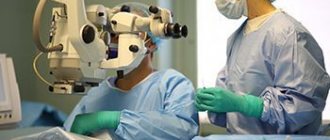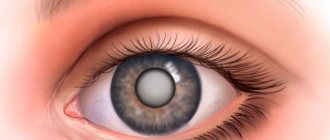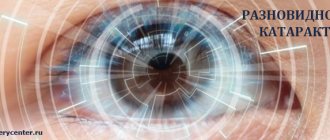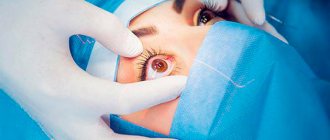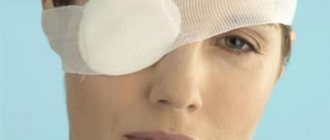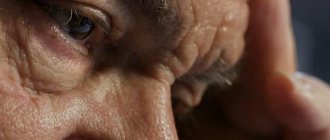Cataract removal and lens replacement is a very serious medical procedure, followed by a long rehabilitation period. It is imperative to follow all the rules and recommendations of doctors to prevent the development of complications.
First, let's figure out what a cataract is.
It is important to understand that a cataract is a partial or complete clouding of the lens located between the iris and the vitreous body. The lens serves as a kind of lens through which light passes and refracts. A clouded lens is not able to perform this function, and a patient with cataracts experiences deterioration in vision, even to the point of loss.
Treatment is carried out surgically, ultrasound or laser phacoemulsification with the introduction of a false lens. The operation is practically the safest of all surgical interventions, but it is very important to properly withstand the recovery of the eye.
How long does rehabilitation take after cataract removal?
Typically, complete recovery takes 6 months , this period may vary depending on the patient’s condition, his age, ability to regenerate, degree of illness, lifestyle and compliance with the postoperative regimen.
The rehabilitation period also depends on the method used to perform the operation.
According to statistics, after laser surgery, recovery is faster and easier than after ultrasound.
Complications and prognosis
The process of removing cataracts is called phacoemulsification. The doctor replaces the clouded lens of the eye with an artificial one. Many people do not realize how important it is to follow the rules of the rehabilitation period.
Complications after surgery to replace the lens of the eye for cataracts arise due to many factors. If vision has not been restored or other adverse consequences have developed after surgery, the person makes an appointment with an ophthalmologist.
Floaters before eyes
Cataracts are differentiated as primary and secondary. The second form appears after the first and has characteristic mechanisms of occurrence. The reasons for the development of such a complication after cataract phacoemulsification include:
- disruption of the endocrine system;
- unusual cell reaction, applies to people with systemic diseases;
- formation of a dense film at the back of the lens capsule.
Secondary cataracts are detected only by examining the structure of the visual organ using special equipment.
Intraocular pressure
The increased intraocular pressure in the early postoperative period after phacoemulsification is explained by:
- disruption of the natural outflow of aqueous fluid from the posterior chamber of the orbit;
- accumulation in the drainage system of viscoelastics, viscous drugs that are used during phacoemulsification to protect the structural surface of the visual organ;
- development of the inflammatory process or sedimentation of particles of the removed lens.
If there is such a complication after cataract removal, eye drops are prescribed. In special cases, another surgical procedure is performed - puncture of the anterior part of the chamber and cleansing.
Why do my eyes water and hurt?
If the eye itches and waters after surgery, this indicates the development of an inflammatory process after cataract removal. The appearance of symptoms is explained by the penetration of infection into the cells during the operation.
Additional symptoms include:
- severe pain;
- profuse lacrimation;
- the occurrence of swelling and swelling of the eyes;
- purulent discharge;
- the eye partially or completely does not see.
For diagnosis, if the eye hurts and festeres after cataract surgery, an analysis of tear fluid and vitreous particles is used. Next, therapeutic therapy is prescribed. In severe cases, additional surgery is performed to remove the pus.
Fog in the eyes, or Irvine Gass syndrome
Blurred vision, or Irvine Gass syndrome, appears one month after cataract surgery. Fluid accumulates in the central part of the retina, causing the macula to swell. Symptoms of the development of Irvine Gass disease include:
- pinkish fog appearing before the eyes;
- distortion of objects;
- fear of light.
To identify the disease, the fundus of the eye is examined using a microscope and an optical tomograph. People with this complication are prescribed anti-inflammatory drugs in tablet or injection form. If treatment fails, a surgical procedure is prescribed.
Corneal edema
When removing mature cataracts, which have a hard structure, the risk of complications due to ultrasound exposure increases. Therefore, a film forms on the cornea after surgery. But the symptom cannot be treated.
If air bubbles appear in the cornea, solutions, ointments and lenses are prescribed. In especially severe cases, the cornea is changed surgically.
Astigmatism, nearsightedness or farsightedness
If the surgical process for removing cataracts and replacing the lens of the eye is disrupted, a complication appears - myopia, farsightedness or astigmatism. This happens for several reasons:
- use of low-quality tools;
- increased intraocular pressure;
- seam overtension.
Diagnosis of the complication is carried out if a person’s vision sharply deteriorates after cataract removal. An ophthalmologist examines the eyelid with a special instrument. Treatment involves wearing lenses or glasses if a person, after cataract surgery, cannot see near or far.
Lens displacement
The ligaments and capsules of the optic organ are torn when the surgeon performs incorrect actions. Therefore, a complication appears after cataract surgery—displacement of the lens.
The following symptoms are characteristic of this defect:
- there is something in the eye that is disturbed and double;
- bright flashes;
- swelling, tumors;
- pain;
- darkness before the eyes.
As a diagnostic measure, fundus examination is prescribed. The complication is treated surgically. During the procedure, the doctor lifts and fixes the lens in its proper place.
Retinal disinsertion
If black spots appear in the eyes after cataract surgery, this indicates the development of retinal detachment. More often, people with myopia are susceptible to this complication. In addition to black dots, flashes and a veil may appear, blocking the view.
To diagnose pathology, several studies are used, intraocular pressure is measured. The defect is corrected through a surgical procedure.
Bleeding
A large artery is located in the choroid of the optic organ. After cataract removal, the occurrence of a rupture of this artery is explained by the presence of the following diseases:
- diabetes;
- glaucoma;
- impaired functioning of the cardiovascular system;
- atherosclerosis.
Sometimes bleeding occurs during a surgical procedure. This is considered a serious complication and requires prompt sealing of the wound.
When bleeding occurs, a person's eyelid becomes red and capillaries are visible. The mucous membrane of the organ swells.
Basic rules for rehabilitation after surgery
There are several care recommendations that must be strictly followed. It is believed that you need to monitor your condition especially carefully during the first 10 days.
With the right approach, following all instructions and daily routine, the postoperative period will pass quickly and without complications.
Compliance with the regime
Adequate rest and moderate activity are necessary, this means 8 hours of sleep. In the first days, it is not recommended to go outside (if necessary, you can only go outside wearing a special bandage).
High-quality nutrition is very important; the menu should be varied and rich in fiber, vegetables and fruits. You can eat dairy products, lean meats, and definitely broths.
This will help avoid constipation; it is not advisable for the first 10 days.
If there is a predisposition, then at first it is necessary to carry out prevention ; it is permissible to use a little herbal laxative.
Sometimes the attending physician prescribes a diet based on individual characteristics, which must be followed.
It is worth giving up bending in any direction . If you need to pick up an object from the floor, then doctors recommend that you first sit down without bending your torso, then bend over a little.
Do not lift heavy objects or carry heavy objects - this can lead to increased intraocular pressure and sometimes hemorrhage.
For the first week, experts recommend sleeping only on the opposite side of the operated eye. This precaution will prevent lens displacement.
During the first 7 days, go outside only wearing a gauze bandage. Do all manipulations on time, namely dressings, instilling drops, regular visits to the doctor, and if there are any signs of complications, attend an unscheduled appointment.
After surgery to remove cataracts, the eye begins to see after 2 hours, but vision loses its sharpness, fogginess and blurriness of objects are possible. Therefore, doctors prescribe wearing glasses during the rehabilitation period .
Lens diopters can vary greatly from each other, and experts insist on individual production; it is strictly forbidden to rent glasses or buy ready-made options. This may cause vision impairment.
Carrying out hygiene procedures
The operation, when the cataract is removed, in the postoperative period involves observing the rules of personal hygiene.
This measure will prevent both viral and bacterial infections, which are the cause of complications.
Daily washing should be done without using cosmetics, with warm, running water, with your eyes closed.
You should bathe in the shower; hot baths should be avoided. When washing your hair, tilt your head back as much as possible to prevent shampoo from getting into your eyes.
Using a special bandage
This is a necessary measure after cataract removal. After surgery, the doctor applies a special bandage. It performs a protective function and is removed only the next day.
Then the patient independently washes the eye daily using furatsilin solution. Cover your eye and blot it several times with a sterile cotton swab.
Then apply a protective gauze bandage. Fold a sterile napkin in half and carefully fix it on your head with a bandage; for better fixation, you can additionally use a plaster.
The operation is cataract, the postoperative period of which requires attention and compliance with all rules.
Using eye drops
During the rehabilitation period, the doctor prescribes medications:
- Anti-inflammatory action is “Indocollir”. This drug is prescribed for a number of diseases, it helps improve vision, prevents the formation of infections, and is a prophylactic agent after operations. Apply drop by drop 3-4 times a day, course - individually;
- Disinfectant action - "Ciprofloxacin" - antimicrobial drops with a wide spectrum of effects. Prescribed for infectious and bacterial diseases, mechanical damage, including surgical intervention. Apply 2 drops up to 8 times for 10 days;
- Combined action drugs - "Tobraex" - are prescribed as an antibacterial agent, removes excessive tearfulness and swelling. Apply 1 drop up to 5 times a day, duration of use – individually;
- "Maxitrol" - relieves inflammation, is prescribed for mechanical damage , and also promotes recovery after various operations, including cataract removal. Apply 1 drop up to 6 times for up to 4 weeks.
Visiting your doctor
It is necessary to come for examination to a specialist the next day after the operation, then after 10 days for a second examination.
But at the first signs of inflammation, complications, severe pain, or sensation of a foreign body, it is worth visiting an ophthalmologist unscheduled.
Also, if you experience the following symptoms, you should immediately consult a doctor:
- a sharp increase in temperature;
- discharge of pus or mucus from the operated eye;
- deterioration of visual acuity.
What happens immediately after surgery?
On the day of the operation, you will have to spend a total of about three hours in the clinic. This time is necessary to prepare for surgery, perform the operation and postoperative examination, after which, having received the necessary medical recommendations, the patient can go home.
It is worth considering that the intervention requires pupil dilation. Therefore, in order to prevent bright sunlight from causing discomfort during the first time after surgery, it is recommended to wear glasses to protect your eyes.
How to properly apply eye drops during rehabilitation
You should lie on your back, tilt your head back a little. Then pull back the lower eyelid with your index finger without using force and drop 1 drop.
Do not touch the dispenser to your eye, keep the bottle upright. If you need to repeat the procedure, you should wait 1-2 minutes and repeat the manipulation.
Remove excess liquid with a clean, sterile napkin and wipe the skin without touching the eye or pressing on nearby tissue.
Fast recovery after surgery
To speed up the recovery process, you should take all possible measures to increase the body's defenses. For this purpose, it is recommended to consume more foods rich in ascorbic acid - cauliflower, citrus fruits, red currants. We should not forget that vitamin E has strong antioxidant properties and helps accelerate the regeneration of damaged tissues. To replenish the body with this vitamin, you should eat nuts, liver, and vegetable oils.
It is recommended to reduce the consumption of fatty, spicy and salty foods to a minimum. The diet should contain foods such as carrots, milk, pumpkin, eggs, fish, fruits and vegetables. It is recommended to replace coffee and strong black tea with a decoction of rosehip or chamomile.
What not to do in the postoperative period after cataract surgery
The operation was performed and the cataract was removed; the postoperative period requires some restrictions:
- Eliminate visual stress - watching TV, working at the computer, reading books;
- Driving any vehicle for up to 6 weeks;
- For 10 days, refrain from using any cosmetics;
- Avoid excessive light, both natural and artificial;
- Do not strain your eyesight in semi-darkness, do not look at objects, do not do housework - the lighting should be soft, harmonious, and pleasing to the eyes;
- Any temperature exposure, both hot and cold, is strictly prohibited - flames from a fire, home oven, cold wind or air flow from a split system;
- Completely avoid physical activity of any kind for 8 weeks;
- Visits to baths, saunas, public swimming pools and beaches - this contributes to the occurrence of various infections in the postoperative period after cataract surgery;
- You must stop drinking any alcoholic beverages for up to 8 weeks. Smoking should be limited to 4 weeks;
- Do an eye massage, press on the eyeball.
Will I have to wear glasses after surgery?
If the latest generation of multifocal artificial lenses are implanted, you will not have to wear glasses after surgery. Thanks to their special design, multifocal lenses imitate the work of the natural lens of the eye, making it possible to clearly see objects both at a distance and near. With such lenses, you can equally easily read a book, watch TV or drive a car; visual work at any distance is not a problem.
Multifocal intraocular lenses make it possible to forget not only about cataracts; implantation of modern artificial lenses makes it possible to restore vision in such eye diseases as astigmatism, myopia and farsightedness, including age-related, otherwise called presbyopia.
Sign up for an excimer clinic and learn more about your health!
You can call by phone
Or click the button and fill out the application form and receive a 5% discount on a full vision diagnostic
Make an appointment
Our address: Moscow, st. Marksistskaya, 3, building 1
"Excimer" on the map of the "Excimer" Clinic in other cities
What to do if complications occur
It is important to know! If, however, water or foam from a cosmetic product penetrates into the operated eye, then it is necessary to immediately rinse with a specially prepared furatsilin solution.
If there is slight redness, it usually goes away after applying the drops.
Inflammatory processes - these include inflammation of the conjunctiva, blood vessels of the eye, and iris. You need to see a doctor. A specialist prescribes anti-inflammatory drops, and within a few weeks the eye returns to normal.
High intraocular pressure - the patient experiences pain in the eye sockets, which may develop into a headache. There is pain in the eyes, and a feeling of heaviness when closed.
The doctor prescribes drops; they stabilize the functioning of the circulatory system of the eyeball.
Hemorrhage is the reddening of the protein as a result of a ruptured vessel - it occurs extremely rarely, is accompanied by pain and may cause blurred vision. You should consult a doctor immediately.
Retinal edema - occurs due to mechanical impact, accompanied by unpleasant sensations and a blurred image. Therapy with eye drops is necessary.
Retinal detachment - patients with myopia are at risk , but if all rules for care after surgery and the use of drops are followed, this complication can be avoided.
Displacement of the lens - occurs when lifting heavy objects and during active physical activity during rehabilitation. Requires immediate surgical intervention.
Rehabilitation after lens replacement
One of the patient’s main tasks during the rehabilitation period is regular eye drops with medicinal solutions prescribed by the doctor. As a rule, several types of drops are used throughout the day, which have anti-inflammatory, bactericidal, and regenerating properties. It is important to strictly adhere to the regimen recommended by the doctor, maintaining intervals between instillations of different drugs.
For recovery, ophthalmologists prescribe the following medicinal solutions:
- Taufon – contains taurine. This substance is an amino acid that activates the processes responsible for the restoration and regeneration of damaged eye tissue. The drops have metabolic properties and are often prescribed for the treatment of cataracts and glaucoma. The medication is contraindicated in patients under 16 years of age and nursing mothers. In most cases, the medicine is tolerated normally, but some patients may experience burning, increased lacrimation, and itching in the eyes.
- Maxitrol - drops based on polymyxin, dexamethasone and neomycin. The active components have corticosteroid and antibacterial effects. The product suppresses the symptoms of inflammation due to the presence of two types of antibiotics in its composition - neomycin and polymyxin. Dexamethasone has an anti-inflammatory effect and is highly active against gram-negative bacteria. Drops cannot be used in the presence of mycobacterial and fungal infections. Sometimes the drug provokes the development of side effects such as pain and itching in the eyes, increased lacrimation, and keratitis.
- Floxal - contains the antimicrobial active substance ofloxacin. It has an effective effect on aerobic and anaerobic organisms, chlamydia, Klebsiella, staphylococcus and other pathogens. Drops are prescribed for infectious eye diseases and corneal ulcers. After instillations, side effects such as redness and burning in the eyes, conjunctivitis, photophobia, keratitis, and dry eyes may develop. The medicine is contraindicated for people allergic to its ingredients, pregnant and nursing mothers. Approved for use by children over 1 year of age.
- Tobrex is an ophthalmic solution based on tobramycin. This component is a fast-acting antibiotic. Tobrex is active against a wide range of pathogenic organisms. During the recovery period after lens removal, it protects the eyes from the development of bacterial infections. The drops do not slow down the recovery processes in the eye corneas, which is why they are actively used after surgical interventions. The medicine is contraindicated in cases of hepatitis B and viral eye lesions, in patients under 1 year of age, as well as in the presence of purulent processes. May cause swelling of the eyelids and discomfort in the eye area.
- Indocollir - drops contain the anti-inflammatory active component indomethacin. The drug belongs to the group of non-steroidal drugs and has analgesic properties. Slows down the process of pupil constriction, which makes it possible to use it during eye surgery. The medicine helps prevent inflammatory processes after surgery to replace the lens for cataracts. The medication is contraindicated in case of renal failure, pregnancy and breastfeeding, and stomach ulcers. It can provoke such adverse reactions as increased tearing, burning, pain in the eyes, blurred vision, photophobia.
Restrictions
Rehabilitation after eye lens replacement involves following the following recommendations:
- limit visual stress. If possible, do not watch TV or work on the computer;
- in the first days you should not wash your hair;
- during the first week it is worth limiting the amount of liquid consumed;
- It is better not to drive a car for a whole month;
- do not sleep on the side of the operated eye and stomach;
- In the first days, avoid getting tap water into your eyes. Then wash your face without using cosmetic foams and gels;
- in the first two days, wear a fixing bandage on the operated eye;
- limit your stay in smoky, dusty rooms;
- Avoid physical activity for a month;
- do not lift weights exceeding three kilograms;
- refuse to visit public swimming pools, saunas, baths;
- in the diet it is better to limit the consumption of table salt, spices, and animal fats;
- men should avoid electric razors that create vibration during the recovery period;
- do not take hot baths;
- Avoid direct sunlight. Go outside with sunglasses;
- You should stop using decorative cosmetics for a month;
- give up bad habits: smoking, including passive smoking, as well as alcoholism;
- Visit your eye doctor as prescribed.
Alcoholic drinks disrupt blood flow in the vessels, interfering with wound healing
What complications can be treated conservatively?
Most complications after replacing the lens of the eye for cataracts are easily eliminated with the help of medications. When the inflammatory process develops, broad-spectrum antibacterial drops (Tobrex, Albucid) and glucocorticosteroids are prescribed. Hemorrhage into the anterior chamber of the eye is treated with hormonal drops (Dexamethasone), mydriatics (Atropine) and special rinses.
Increased intraocular pressure in the early postoperative period is also treated conservatively. Treatment of the eye after surgery for the development of glaucoma is carried out with Pilocarpine or Timolol drops. The doctor can also rinse the clogged ducts of the eyeball using a puncture. Sometimes, as a result of cataract removal, the shape of the cornea changes, resulting in astigmatism. When such a complication occurs, optical correction is performed. To eliminate this phenomenon in a timely manner, you need to consult a doctor immediately if black spots appear before your eyes.
